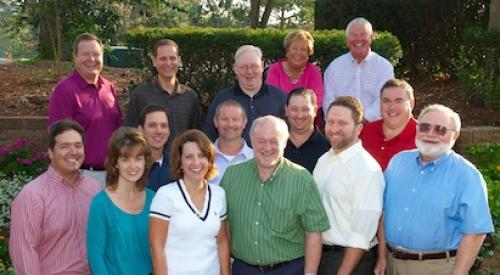Success can be a curse to some home-building companies. Systems that work well at small volumes can break down with an increase in sales and production. That easily could have been the fate of DSLD Homes, as the start-up builder in Denham Springs, La., experienced rapid growth. In 2011, just three years after opening its doors, DSLD was named Builder of the Year by Professional Builder.
“It’s almost a problem when you win Builder of the Year because people think, ‘We’ve got this,’” says DSLD’s product development director Ryan Nash. “We want them thinking, ‘What do we need to do today to get a little better?’”
That explains, perhaps, the company’s almost-fanatical fixation on continuous improvement. President Saun Sullivan and Nash hit the road one to three times a month, visiting other builders to learn best practices they can take home and adapt to their system of delivering high-quality, completed homes on time with high customer satisfaction.
“Never have I seen a company that wants to learn the way they do,” says Bill Saint, president of Charlotte, N.C.-based Classica Homes and NHQ’s lead examiner for DSLD Homes’ site visit. “It’s all driven by Saun. He is a continuous learner. They find something they want to learn and find a builder who’s doing it well. They have personally toured over 40 builders. It blew me away that they’re out there looking for the best practices.”
NHQ Silver Award
DSLD Homes
Denham Springs, La.
Founded: 2008
Markets: Baton Rouge, Layfayette, Gulfport-Biloxi,
New Orleans
2011 revenue: $115.85 million
2011 closings: 687Quality Best Practices
• Detailed scopes of work — The builder uses photos, illustrations, and detailed instructions in their scopes to ensure that all homes are built correctly from the beginning.
• Trade contractor report card — DSLD tracks the performance of their trades on an almost daily basis, using review sheets placed at every jobsite.
• “Even flow” construction model — The builder adopted Rayco’s model for production scheduling, where a certain number of homes are started each week and the same number of homes are completed each week. This approach ensures that all trades know where they are suppose to be and when.
• Trade relations — DSLD gets the best work out of their trade contractors, in part, because they pay within two days of completing the work.
The examining team noted that in achieving NHQ Silver status, DSLD scored the highest in the business results category, indicating a solid connection between their strategic initiatives and the results being achieved. Driving much of the company’s performance — including its stunning 46-day cycle time and its high level of construction quality — is DSLD’s extraordinary commitment to its trade partners.
Trade partners are selected first on their ability to do the job right and on time and then on price. “If the first two questions can’t be answered adequately, then the third doesn’t matter,” says Sullivan. Trades are paid within two days of completing the work, even without submitting an invoice, and they don’t have to worry about charge backs.
“Can you do the job right?” is DLSD-speak for “Will you do the job the way we want it done?” It’s a question that has cost them some subs in the past who have balked at being told how to do their jobs. But Nash says that consistency across communities increases efficiency, cuts down on errors, improves quality, and reduces warranty costs.
Each trade gets detailed plans and field guides with visual scopes of work and measurements. “The main goal is to tell everybody exactly what you want,” Nash says. “We don’t want to bring them back to get them to do things. It makes our superintendents less efficient. We want to wrap windows the same way in every house. The more things you can standardize, the better.”
That doesn’t mean that Nash thinks his way is the only way. He gets hot-spot reports each month on what’s working and what’s not. “We’re not above changing things,” he says. “We take input from everyone in the system.”
DSLD also has a system that allows trade contractors to rate the trade who preceded them for finishing the work on time and leaving them with a clean, job-ready site.
Saint was impressed. “The trades are getting paid every two days. They will push other work aside for DSLD,” he says. “And they get to do their job. They show up to a jobsite and it’s ready. They don’t get bumped around. That’s where they make money.”
New work is awarded based on on-time completion and quality scores. The system helps identify contractors who can handle extra work and correct problems before they get out of control.
“If their scores are slipping, we can guess that they’re getting a divorce or are having some other issue,” Nash says. “If I have a vendor with problems, the first thing I do is go to counseling with them. ‘You’re not doing a good job’ is a different conversation than ‘You have a problem. How can we help you?’”
Personnel Growth Tops Areas for Improvement
Going through the NHQ process, Sullivan says, has shown them that as a young, growing company, DSLD still has work to do. While the builder has done a great job with creating systems for measuring results with its trade partners, it needs to work on a similar process for its staff.
In their feedback report, the examiners noted that they found no data on employee satisfaction and limited efforts in regard to workforce development, employee rewards, or recognition. Employee development activities aren’t linked to company objectives. The examiners said DSLD needs to determine what skill improvements are needed to support company goals and develop a plan to achieve them. They also recommended that DSLD consider making all employees aware of any new position and offer it to them first, regardless of whether DSLD management would rather keep a person in their current position.
“We spend a lot of time on the outside people,” says Sullivan. “The feedback report made us realize that we have to spend time on the inside people. We concentrate on the sales, superintendents, and warranty guys. It’s the internal people who keep the trains moving. I think we’ve missed a little bit on that.”
Looking forward, there’s work to be done in the area of strategic planning, as well. The examiners said it was “unclear if a written strategic plan exists” and recommended that DSLD develop a long-range vision of what the company is to become and a plan to get there.
“As with any growing company, they certainly have areas they could work on,” Saint says. “Communication is a challenge in their company. They’ve added a lot of people. As they grow, they will have to tighten up on formal strategic planning, the HR side, and communications. They’re getting big. It’s a necessity.”
Sullivan says the company will focus on those areas in the coming year. “We have had a lot of people go with us to places, but you can only get so far when you’re not telling them why,” he says.
Overall, Saint says the company is doing a lot of things incredibly well.
“What I walked away with was, ‘Dang, you’re doing great,’” Saint says. “Your trades love you, you have great customer satisfaction, and great quality. Your scheduling is bulletproof. That’s amazing when you’re running and growing as fast as they have.”













